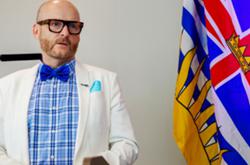A new health survey of nearly 40,000 B.C. teenagers offers a mixed bag of news about their well-being.
The results of the 2023 B.C. Adolescent Health Survey, organized by the McCreary Centre Society, were released Feb. 21.
Responses to the survey, conducted over the spring of 2023, came from 38,488 youth aged 12 to 19, studying in 59 of the province’s 60 public school districts. Only the Peace River North district did not have the capacity to participate.
The survey asked students over 146 questions about their lives, from their eating, exercise and sleep habits, to their cellphone usage, relationships, sexual activity and substance use, to their mental health, body image and whether they felt safe in school.
While self-reported substance use and sexual activity are at some of the lowest rates in the survey’s 32-year history, teenagers who do partake are starting younger. And mental distress, particularly for female and non-binary students, has increased.
“Most of the kids are doing well. They’re healthy, they’re happy. But there’s some who are in trouble,” said Annie Smith, executive director of the McCreary Centre Society.
For Smith, the top concerns emerging from the survey are self-harm, earlier substance use, unprotected sex and social isolation.
Newly appointed Minister of Children and Family Development Grace Lore, who could not attend the launch, made a video address thanking McCreary Centre Society for producing a survey that helps inform ministry decisions.
“It provides valuable information, input and solutions on youth health and well-being, directly from youth themselves,” Lore said.
Here are some of the most concerning and most encouraging findings — often from the same category — from the 2023 B.C. Adolescent Health Survey.
Mental health and self-harm
The 2023 survey is the first to take place after the COVID-19 pandemic shut down schools for much of the spring 2020 semester and transformed teaching and learning in the 2020-21 school year.
It also comes on the heels of five years of record forest fires, floods, droughts and repeated dire warnings about the impacts of human-accelerated climate change.
All this is having an impact on young people’s mental health, Smith said.
Sixty per cent of young people reported “good” or “excellent” mental health. That’s down from 73 per cent in 2018 and 81 per cent in 2013. Only half of females and 22 per cent of non-binary students reported positive mental health, compared with 73 per cent of males.
Just 59 per cent of young people feel hopeful about their future, down from 66 per cent in 2018.
“They’re less likely than five years ago to think that life is going well, that they have a good life,” Smith said. “And more likely to wish that they had a different life.”
A small number of young people (13 per cent) said they missed a couple of school days due to poor mental health. This statistic was highest for students in grades 11 and 12. Youth in lower grades were more likely than their older peers to report positive mental health.
Smith said the number of youth who reported cutting or injuring themselves was “shocking.” Almost one-quarter of youth are self-harming without the intent to kill themselves, up from 17 per cent in 2018 and “a big rise” from a decade ago.
Males are more likely to harm themselves by getting into a physical fight and females are more likely to starve themselves. Non-binary youth were four times as likely as males to have self-harmed in the past 12 months, and over four times as likely to have considered or attempted suicide.
Nearly three-quarters of young people reported not needing mental health services in the past 12 months, while another 11 per cent did and accessed them. But 18 per cent of young people reported not being able to access the mental health services they needed, with the majority (58 per cent) reporting it was because they didn’t want their parents to know.
Talon Nadeau, a member of the Piapot First Nation who grew up in East Vancouver, and one of eight young musicians who put together a song and music video based on the survey responses, said he knows how difficult it is to access mental health care.
“I was trying to get counselling for about half a year, and I just couldn’t find anyone,” Nadeau said. “Finally it came about and now I’m in counselling and it’s really good.”
Smith noted that the province has made positive steps for child and youth mental health services, including offering support through Foundry clinics, which young people can access for free.
But the challenge, she said, is that many young people are unaware these clinics exist, don’t have a clinic in their community or are unable to access them for other reasons, like needing a ride from an adult. Interventions are needed earlier to remove stigma around admitting they need mental health help, Smith added.
Substance usage is down, but starting younger
Overall, youth are using fewer substances such as alcohol and cannabis. But those who do use substances are starting younger.
Just over a quarter of students reported vaping. The most common starting age was 13. Smoking continued its 30-year decline; just 15 per cent of students reporting ever lighting up a cigarette, compared with 60 per cent in the first survey in 1992.
Alcohol use was also at its lowest rate in the survey’s history, with just 38 per cent of students having had a drink. But the most common starting age was 14.
Despite legalization in 2018, cannabis use dropped to 22 per cent from 25 in 2018. Most young people reported their first time trying the drug at age 14 or 15. But there was a slight increase in how many young people first tried cannabis at age 12: 15 per cent, up from 14 per cent in 2018.
Earlier substance use is concerning, Smith said, “because we know that the younger people start to use, the more likely they are to go on to have problems with that use.”
Just 14 per cent of young people had tried other substances, including mushrooms and a higher dose of their prescription medicine than prescribed.
Survey results were released on the heels of news that the province would not prevent the pending closure of a 10-bed treatment program for youth dealing with concurrent mental health and addictions issues in North Vancouver. The only facility of its kind in Western Canada, it is scheduled to close on March 15.
Sexuality, gender and sexual activity
Half of respondents identified as male, 45 per cent as female and five per cent as non-binary — up from just two per cent of youth in 2018.
Three-quarters of young people identified as “straight” or heterosexual, a decline from 81 per cent in 2018. Students in older grades were more likely to be sure about their sexuality, and more likely to identify as pansexual and bisexual, than their younger peers.
Sexual activity among young people continues to decline. Just 17 per cent of students reported having tried oral sex, a drop from 26 per cent in 2008. Sixteen per cent had tried intercourse, with the most common age for their first time at 15. Sexual experience was most common in older grades.
But Smith is concerned about the high-risk sex youth are having. There was an increase in youth — 39 per cent — who reported using the pullout method as a form of birth control. Only 53 per cent of youth report using condoms during intercourse, a similar response rate to the 1992 survey.
At the same time more youth — 19 per cent versus 17 per cent in 2018 — reported using barriers for oral sex.
“I think we put a lot of effort into explaining to young people that if they’re sexually active there are risks associated with oral sex, but we seem to have forgotten with intercourse where we see the drop in condom use. So that’s concerning,” Smith said.
Seven per cent of students reported being forced into sex by another student, while two per cent had been by an adult. The gender breakdown showed non-binary (18 per cent) and female (12 per cent) students were more likely to report being forced into sexual activity than their male (four per cent) peers.
Relationships and loneliness
Smith said she’s concerned to see that kids have fewer friends and are doing fewer in-person activities.
Ninety-four per cent of kids said they have at least one close friend in their school or neighbourhood. This has decreased slightly since 2019, while the number of kids who reported having close friends online has increased slightly.
Most students reported having three or more friends, something the report links to positive outcomes for youth. But at 69 per cent of respondents, that is a decline from 2018, when 81 per cent of youth reported having that many friends.
Seventy-three per cent of youth reported getting along with people around them, the same percentage who said they had at least one trusted adult in their lives who wasn’t family or a school community member. Two-thirds of Grade 7 students felt connected to their family, though that decreased with age.
A quarter of young people reported feeling lonely often or always, with a higher percentage of teenagers feeling that way in older grades.
Improving outcomes for some vulnerable youth
Asked about good news in the report, Smith pointed to how more Indigenous youth are learning their ancestral language, with 32 per cent reporting they know a handful of words and phrases (up from 28 per cent in 2018), and two per cent saying they are fluent.
Raven’s Children VI, a report analyzing responses from the Indigenous students who participated in the broader survey, is forthcoming from McCreary’s Young Indigenous Research Team.
It’s also good to see how supports for youth transitioning out of care at age 19 are starting to show results, Smith said. There was little in the survey about government care experience, but since 2018 financial, education and housing supports for youth from care have increased, with some support available indefinitely.
Nina Sunday, a participant in McCreary’s Youth Research Academy program for youth from care, said the report certainly has “heavy themes.” But she tries to hold on to the hope that young people do have, especially now that supports have expanded for youth from care.
“I would like to see increased mental health supports for youth,” she said.
A report from McCreary’s Youth Research Academy is coming in the near future about the health and life experiences of young people in and from government care.
Smith also noted the data on cellphone and tablet use was mixed, with fewer teenagers reporting using their devices to access pornography or engage in sexting. But 18 per cent of students identified being told or feeling like they needed help with their social media usage.
Swimming lessons as the canary in the coal mine
Rates of school connectedness and feelings of safety were both down. While most students still felt safe in supervised areas like the library and classroom, safety rates plummeted for change rooms (72 per cent, compared with 85 per cent in 2018) and washrooms (68 per cent, compared with 86 per cent in 2018).
Asked why, Smith told The Tyee they did not ask students for specifics on why change rooms and washrooms felt unsafe. But on the final page of the survey students were given space to add comments, and some indicated their school’s decision to remove washroom doors to prevent vaping — or the presence of others vaping in the washroom — led to them feeling unsafe there.
Non-binary youth reported feeling the least safe in these rooms, and the most likely to be bullied, Smith added. In a tragic coincidence, on the same day the report was released, news broke of a non-binary student in Oklahoma who died following a violent attack in a school bathroom, a year after trans students in the state were banned from using bathrooms matching their gender.
While some schools have introduced gender-neutral washrooms for students, or made all washrooms gender neutral to support trans and non-binary students, anti-LGBTQ2S+ rhetoric has made bathroom access a political lightning rod.
Students who reported feeling most connected with their school were more likely to report positive mental health and hope for their future. But it wasn’t just school: young people who felt most connected to the land and to nature also reported higher ability to handle stress in their lives.
Students who lacked one or more items from McCreary’s 11-point material deprivation index — which includes access to funds for personal use, hygiene products, appropriate clothing, a quiet space to sleep and more — were less likely to report positive mental health, a positive outlook on life or hopefulness for the future.
One survey result that Smith said surprised and concerned her is how few kids knew how to swim, or considered themselves strong swimmers. Nine per cent of kids said they didn’t know how to swim, and 29 per cent said they were “not confident” swimmers.
“That talks about the barriers in a nutshell,” she said. “It’s hard to get access if you live in poverty, you’ve got no adults whose responsibility it is to teach kids how to swim. It’s all these issues, which is why it stood out to me.” ![]()
Read more: Health, Rights + Justice, Education, Gender + Sexuality


















Tyee Commenting Guidelines
Comments that violate guidelines risk being deleted, and violations may result in a temporary or permanent user ban. Maintain the spirit of good conversation to stay in the discussion and be patient with moderators. Comments are reviewed regularly but not in real time.
Do:
Do not: